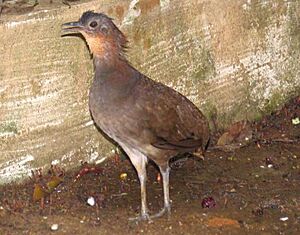Brazilian tinamou facts for kids
Quick facts for kids Brazilian tinamou |
|
|---|---|
 |
|
| Conservation status | |
| Scientific classification | |
| Genus: |
Crypturellus
|
| Species: |
strigulosus
|
 |
|
The Brazilian tinamou (Crypturellus strigulosus) is a special bird that lives in the Amazon rainforest in South America. It's a type of tinamou, which are birds known for being a bit shy and living on the ground in forests. You can find them in warm, wet lowland forests across parts of the Amazon.
Contents
What's in a Name?
The scientific name for the Brazilian tinamou is Crypturellus strigulosus. The first part, Crypturellus, comes from old Latin and Greek words.
- kruptos means 'covered' or 'hidden'.
- oura means 'tail'.
- ellus means 'small'.
So, Crypturellus basically means 'small hidden tail'. This name fits well because tinamous often keep their tails tucked away!
Family Tree: What Kind of Bird Is It?
The Brazilian tinamou is a "monotypic species." This means it's the only species in its group, and there are no different subspecies of it. All tinamous belong to the bird family called Tinamidae.
Tinamous are also part of a larger group of birds called ratites. Other ratites include ostriches, emus, and rheas. What makes tinamous special is that, unlike most other ratites, they can fly! They aren't super strong fliers, but they can get off the ground. Scientists believe all ratites came from birds that could fly a long, long time ago. Tinamous are thought to be the closest living relatives to those ancient flying birds.
What Does It Look Like?
The Brazilian tinamou is about 28 centimeters (11 inches) long. Its upper body is a reddish-brown color. It has a reddish throat and a grey chest. Its belly is whitish, and its legs are brown.
Female Brazilian tinamous look a bit different. They have clear black stripes and a yellowish-brown color on their upper parts.
How Does It Live?
Like other tinamous, the Brazilian tinamou mostly eats fruit that has fallen to the ground or grows on low bushes. They also snack on small amounts of invertebrates (like insects), flower buds, soft leaves, seeds, and roots.
When it comes to raising a family, the male tinamou does most of the work! He incubates the eggs, which can come from up to four different females. After the chicks hatch, he takes care of them until they are ready to be on their own. This usually takes about two to three weeks. The nest is built on the ground, often hidden in thick bushes or between large tree roots.
Where Does It Live?
The Brazilian tinamou makes its home in tropical or subtropical lowland moist forests. They can be found in areas up to 500 meters (1,640 feet) above sea level. This bird is native to northwestern Bolivia, the southern part of the Amazon Rainforest in Brazil, and eastern Peru.
Is It Safe?
The IUCN (International Union for Conservation of Nature) lists the Brazilian tinamou as a species of "Least Concern." This means that, for now, there are plenty of these birds, and they are not considered to be in danger of disappearing. They live across a very large area, covering about 2.6 million square kilometers (1 million square miles).


